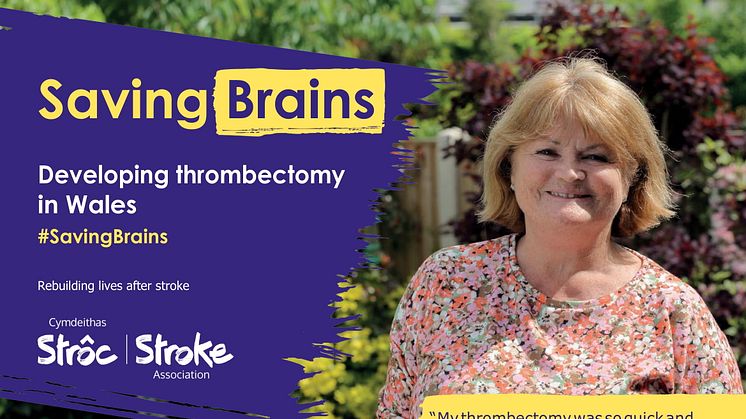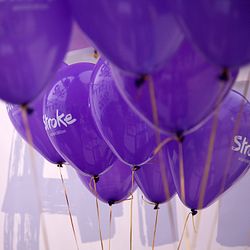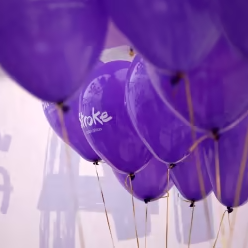
Press release -
Stroke patients in Wales missing out on a miracle treatment/ Mae cleifion strôc yng Nghymru ar eu colled o fethu â chael triniaeth wyrthiol
- Just 33 stroke patients received miracle treatment, with hundreds missing out1
- - Treating all suitable patients would save the health and care system over 20 million pounds in Wales2
- Some stroke units in Wales did not refer any stroke patients for a thrombectomy in 2020/213
- It saves brains. Thrombectomy is a very powerful treatment and significantly reduces disability. 39% of thrombectomy patients experience reduced disability and 20% achieve functional independence after the treatment. Treating everyone who needs a thrombectomy in Wales would mean more people were independent after their stroke, and live with fewer disabilities like paralysis, visual impairment and communication difficulties.
- It saves money. Thrombectomy is extremely cost-effective, saving the NHS £47,000 on average over five years per patient.5 These savings could be reinvested in healthcare services.
- It even saves lives. Thrombectomy can treat severe strokes that could cause multiple disabilities or even death.
- Lack of stroke specialist staff, including INRs
- Delays in stroke patient arrival at hospital
- Patient transfer and imaging challenges
- Restricted opening times of thrombectomy services
- A delayed national strategic approach to stroke
A new report by the Stroke Association released today warns that stroke patients in Wales are missing out on the game changing acute stroke treatment, mechanical Thrombectomy.
The Stroke Association’s ‘Saving Brains’ report calls on the Welsh Government to take action to improve access to thrombectomy including publishing the new updated stroke delivery plan to support the Quality Statement for stroke. The new delivery plan should give clear expectations, timescales and outcomes for stroke services in Wales across the stroke pathway, including thrombectomy, addressing existing barriers, as well as, prioritizing the development of new modern stroke units able to develop their own thrombectomy services.4
Mechanical thrombectomy is a procedure whereby a stent is used to manually remove large stroke-causing blood clots from the brain via a catheter inserted into the patient’s groin. The procedure vastly reduces disability and has been known to reduce hospital stay by a large number of months, with some patients being able to leave the next day, rather than spending months in hospital. The procedure has been described as one of the most effective procedures ever discovered.
Why do we need to develop thrombectomy services in Wales?
Thrombectomy rates vary across Wales. Despite an estimated 500 people potentially being eligible for thrombectomy in Wales each year, the numbers currently able to access the treatment falls significantly short of this. Just 33 patients in Wales received a thrombectomy in 2020/21. Of these, 13 received the treatment in University Hospital of Wales in Cardiff, with the other 20 patients receiving the treatment at thrombectomy centres in England.6
This means that despite 10% of stroke patients potentially being eligible for thrombectomy, only 0.74% of patients in Wales actually received the treatment in 2020/21.6 For comparison, the current rate in England is 2.2%, and Northern Ireland 4.1%.7 This is also considered not good enough in comparison to rates across Europe.
There are a number of reasons behind the low rate of thrombectomy in Wales. This includes8:
The barriers to improving thrombectomy rates are complex. One of the biggest challenges is a lack of specialists (Interventional Neuroradiologists or INRs) trained to deliver the treatment in Wales, with just two currently employed in Cardiff. As a result, services used by Welsh patients are not available 24 hours a day, 7 days a week for all those who need the treatment.
Thrombectomy is a very time-sensitive treatment. The quicker the procedure happens; the more brain tissue the doctor can save. This is because for every minute a stroke is left untreated, 1.9 million brain cells die. Thrombectomy can be performed up to 24 hours after a stroke, but it is most effective in the first six hours9. Lengthy ambulance response times, lengthy handovers and delayed inter-hospital transfers are another reason many patients miss out on thrombectomy.
Katie Chappelle, Associate Director for Wales, Stroke Association said: “Thrombectomy is a miracle treatment that pulls patients back from near-death and alleviates the worst effects of stroke. It’s shocking that so many patients are missing out and being saddled with unnecessary disability. It really is simple. Thrombectomy saves brains, saves money and changes lives.”
“There is an unacceptable postcode lottery of stroke treatment, at a time when tackling health inequalities is a key priority for the government and NHS. We are concerned that despite commissioned arrangements being in place with the Walton Centre in Liverpool and Southmead Hospital in Bristol, few patients are accessing thrombectomy at these centres, and there are several Welsh hospitals where no patients are accessing the treatment. A postcode lottery for thrombectomy has been created in Wales, where stroke patients in some areas are much more likely to receive the treatment than those living in other areas due to access. We recognise the number of thrombectomies being carried out is rising and this is welcome. Although, it still remains just a small fraction of those who could benefit from the treatment with the vast majority missing out on a life changing treatment. “
Katie concludes, “Despite the release of the Quality Statement in September 2021 there has been very little further information on the detail within the new delivery plan for stroke. This means we lack the required detail on how thrombectomy fits in with the vision, what the expectations are for the rollout of thrombectomy services in Wales, and how the challenges for developing these services will be addressed.”
The difference in recovery for stroke survivors who have had a thrombectomy and those who haven’t is apparent in the stories of Gareth Hale and Stephen Attwood.
Gareth Hale, 66 years old from Bassaleg, Newport had a stroke in April 2021. He collapsed in the front garden of his home and was found by his neighbour immediately who called 999. There was a two hour-delay getting the former English teacher to hospital, therefore he missed the window of opportunity to be thrombolised or given a thrombectomy.
Lisa Hale, Gareth’s daughter said “My dad got to the Grange hospital at 7.30pm in the evening meaning the stroke unit in Cardiff, Heath hospital where a thrombectomy could have been performed was closed. It really is a postcode and time lottery on whether you can have access to a thrombectomy. If my dad had his stroke a few hours earlier, things may have been different and that really shouldn’t be the case.”
Gareth, who was running his own online English teaching business, has now lost all his written and verbal communication, cannot use his right arm or walk unaided Lisa said, “For someone who loved communication, languages and singing, we can’t even describe the trauma he is currently experiencing. His business, hobbies and life as he knew it is now over. That night we nearly lost Dad. He did pull through though, however what he’s left with is devastating. It’s like he’s trapped in his own body.”
Whereas, father of two, Stephen Attwood, from Bridgend had a stroke in 2017 when he was just 36 years old. He was one of the handful of people from Wales who were given a thrombectomy that year.
“It saved my life, without it I wouldn’t be where I am today. I got lucky, my stroke was on a weekday morning and I live fairly near the border with England so was able to be transferred to Bristol. If it had happened at a busy time, I might not have had the procedure and might never have been able to speak again.
“Thrombectomy should be available to everybody- it shouldn’t be pot luck. If there’s a chance to get the clot out of your brain, it needs to happen.”
The Stroke Association is calling on Welsh Government to act on the recommendations in our Saving Brains report and publish the new delivery plan which will map out thrombectomy services in Wales ensuring everyone who can have a thrombectomy gets it.
ENDS
Interviews are available in Welsh and English. For more information on the story, please contact laura.thomas@stroke.org.uk.
Notes to Editors
Stroke Association
- - Stroke strikes every five minutes in the UK and it changes lives in an instant.
- - The Stroke Association is a charity working across the UK to support people to rebuild their lives after stroke. We believe that everyone deserves to live the best life they can after stroke. From local support services and groups, to online information and support, anyone affected by stroke can visit stroke.org.uk or call our dedicated Stroke Helpline on 0303 3033 100 to find out about support available locally.
- - Our specialist support, research and campaigning are only possible with the courage and determination of the stroke community and the generosity of our supporters. With more donations and support, we can help rebuild even more lives.
References
1Sentinel Stoke National Audit Programme, SSNAP Annual Portfolio for April 2020-March 2021 admissions and discharges: National Results. Available: https://www.strokeaudit.org/Documents/National/Clinical/Apr2020Mar2021/Apr2020Mar2021- AnnualResultsPortfolio.aspx Worked out 500 (estimated patients who missed out) multiplied by the estimated £47,000 per patient saved.
2 Stroke Association, Current, future and avoidable costs of stroke in the UK, January 2018. Available: https://www.stroke.org.uk/site... default/files/costs_of_stroke_in_the_uk_economic_case_interventions_that_work.pdf
3 Stroke Association Saving Brains (2022).Pg.12
4 Stroke Association Saving Brains (2022).
5Sentinel Stoke National Audit Programme, SSNAP Annual Portfolio for April 2020-March 2021 admissions and discharges: National Results. Available: https://www.strokeaudit.org/Documents/National/Clinical/Apr2020Mar2021/Apr2020Mar2021- AnnualResultsPortfolio.aspx
6. Figures provided by the Welsh NHS Delivery Unit, compiled from SSNAP data.
7 Ibid. The Wales total includes those who received a thrombectomy in an English hospital but were originally admitted to a Welsh hospital. These patients are then removed from the England total, so they are not double-counted.
8Stroke Association Saving Brains (2022).pg.14
9 National Institute for Health and Care Excellence, Stroke and transient ischaemic attack in over 16s: diagnosis and initial management, 1 May 2019. Available: https://www.nice.org.uk/guidance/NG128
Welsh Translation
Mae cleifion strôc yng Nghymru ar eu colled o fethu â chael triniaeth wyrthiol
- - Dim ond 33 o gleifion strôc a dderbyniodd driniaeth wyrthiol, gyda channoedd yn methu â’i chael1
- Byddai trin pob claf addas yn arbed dros £20 miliwn i’r system iechyd a gofal yng Nghymru2
- Ni wnaeth rhai unedau strôc yng Nghymru atgyfeirio unrhyw glaf strôc am thrombectomi yn 2020/213
- Mae’n arbed ymenyddiau. Mae thrombectomi yn driniaeth nerthol iawn ac mae’n lleihau anabledd yn sylweddol. Mae 39% o gleifion thrombectomi yn profi llai o anabledd ac mae 20% yn gallu cael annibyniaeth weithredol ar ôl y driniaeth. Byddai trin pawb sydd angen thrombectomi yng Nghymru yn golygu bod mwy o bobl yn annibynnol ar ôl eu strôc, ac yn byw â llai o anableddau fel parlys, nam ar y golwg ac anawsterau cyfathrebu.
- Mae’n arbed arian. Mae thrombectomi yn eithriadol o effeithiol o ran cost, gan arbed £47,000 y claf ar gyfartaledd dros bum mlynedd i’r GIG.5 Gellid ail-fuddsoddi’r arbedion mewn gwasanaethau gofal iechyd.
- Mae hyd yn oed yn arbed bywydau. Gall thrombectomi drin strociau difrifol a allai beri llu o anableddau neu hyd yn oed farwolaeth.
- Prinder staff arbenigol mewn strôc, yn cynnwys Niwroradiolegwyr Ymyriadol;
- Oediadau cyn i gleifion strôc gyrraedd ysbyty;
- Heriau o ran trosglwyddo a delweddu cleifion;
- Amseroedd agor cyfyngedig mewn gwasanaethau thrombectomi;
- Ymagwedd strategol genedlaethol ohiriedig tuag at strôc.
Mae adroddiad newydd gan y Gymdeithas Strôc a gyhoeddir heddiw yn rhybuddio bod cleifion strôc yng Nghymru ar eu colled o fethu â chael y driniaeth sy’n newid y sefyllfa’n llwyr ar gyfer strôc aciwt, sef Thrombectomi mecanyddol.
Mae adroddiad ‘Arbed Ymenyddiau’ gan y Gymdeithas Strôc yn galw ar Lywodraeth Cymru i weithredu i wella modd o gael at thrombectomi, yn cynnwys cyhoeddi’r cynllun cyflawni newydd a ddiweddarwyd ar gyfer strôc i ategu’r Datganiad Ansawdd ar gyfer strôc. Dylai’r cynllun cyflawni newydd roi disgwyliadau, graddfeydd amser a deilliannau eglur ar gyfer gwasanaethau strôc yng Nghymru ledled y llwybr strôc, yn cynnwys thrombectomi, a rhoi sylw i rwystrau presennol, yn ogystal â blaenoriaethu’r gwaith o ddatblygu unedau strôc modern newydd sy’n gallu datblygu’u gwasanaethau thrombectomi eu hunain.4
Mae thrombectomi mecanyddol yn driniaeth drwy’r hyn y defnyddir stent i gael gwared drwy law â tholchenni gwaed mawr sy’n peri strôc o’r ymennydd drwy gathetr a fewnosodir i mewn i werddyr y claf. Mae’r driniaeth yn lleihau anabledd yn enfawr ac mae’n hysbys ei bod yn lleihau arosiadau mewn ysbyty o nifer fawr o fisoedd, gyda rhai cleifion yn gallu gadael trannoeth, yn hytrach na threulio misoedd mewn ysbyty. Disgrifiwyd y driniaeth fel un o’r triniaethau mwyaf effeithiol a ddarganfuwyd erioed.
Pam mae arnom angen datblygu gwasanaethau thrombectomi yng Nghymru?
Mae cyfraddau thrombectomi yn amrywio ledled Cymru. Er gwaethaf yr amcangyfrifir fod 500 o bobl yn ddichonol yn gymwys ar gyfer thrombectomi yng Nghymru bob blwyddyn, mae’r niferoedd sydd ar hyn o bryd yn gallu cael at y driniaeth yn sylweddol fyr o hyn. Dim ond 33 o gleifion yng Nghymru a dderbyniodd thrombectomi yn 2020/21. O’r rhain, derbyniodd 13 y driniaeth yn Ysbyty Athrofaol Cymru yng Nghaerdydd, gydag 20 o gleifion eraill yn derbyn y driniaeth mewn canolfannau thrombectomi yn Lloegr.6
Er gwaethaf y ffaith bod 10% o gleifion strôc yn ddichonol yn gymwys ar gyfer thrombectomi, golyga hyn mai dim ond 0.74% o gleifion yng Nghymru mewn gwirionedd a dderbyniodd y driniaeth yn 2020/21.6 O’i gymharu, y gyfradd gyfredol yn Lloegr yw 2.2%, ac yng Ngogledd Iwerddon mae’n 4.1%.7 Ystyrir hefyd nad yw hyn yn ddigon da o’i gymharu â chyfraddau ledled Ewrop.
Mae yna nifer o resymau wrth wraidd y gyfradd isel o thrombectomi yng Nghymru. Mae hyn yn cynnwys8:
Mae’r rhwystrau rhag gwella cyfraddau thrombectomi yn gymhleth. Un o’r heriau mwyaf yw prinder arbenigwyr (Niwroradiolegwyr Ymyriadol neu INRs) sydd wedi’u hyfforddi i gyflenwi’r driniaeth yng Nghymru, gyda dim ond dau ar hyn o bryd yn cael eu cyflogi yng Nghaerdydd. O ganlyniad, nid yw gwasanaethau a ddefnyddir gan gleifion Cymru ar gael 24 awr y dydd, 7 niwrnod yr wythnos i’r holl bobl hynny sydd angen y driniaeth.
Mae thrombectomi yn driniaeth sy’n hynod sensitif i amser. Po gyflymaf y mae’r driniaeth yn digwydd, mwyaf o feinwe’r ymennydd y gall y meddyg ei arbed. Mae hyn oherwydd am bob munud na chaiff strôc ei thrin, mae 1.9 miliwn o gelloedd yr ymennydd yn marw. Gellir perfformio thrombectomi hyd at 24 awr ar ôl strôc, ond mae o’n fwyaf effeithiol yn y chwe awr gyntaf9. Mae amseroedd ymateb hir gan ambiwlansys, trosglwyddiadau hir a throsglwyddiadau gohiriedig rhwng ysbytai yn rheswm arall pam mae llawer o gleifion yn methu â chael thrombectomi.
Dywedodd Katie Chappelle, Cyfarwyddwr Cyswllt i Gymdeithas Strôc Cymru: “Mae thrombectomi yn driniaeth wyrthiol sy’n tynnu cleifion yn ôl o borth angau ac mae’n lleddfu effeithiau gwaethaf strôc. Mae’n frawychus bod cynifer o gleifion yn colli’r driniaeth ac yn cael eu llethu gan anabledd diangen. Mae’n wir syml. Mae thrombectomi yn arbed ymenyddiau, mae’n arbed arian ac mae’n newid bywydau.”
“Mae yna loteri cod post annerbyniol o driniaethau strôc, ar adeg pan fo gorchfygu anghydraddoldebau iechyd yn flaenoriaeth allweddol i’r llywodraeth ac i’r GIG. Er gwaethaf y ffaith bod trefniadau a gomisiynwyd ar waith â Chanolfan Walton yn Lerpwl ac Ysbyty Southmead ym Mryste, rydym yn pryderu bod ond ychydig o gleifion yn cael at thrombectomi yn y canolfannau hyn, ac mae yna amryw o ysbytai yng Nghymru lle nad oes yr un claf yn cael at y driniaeth. Crëwyd loteri cod post o ran thrombectomi yng Nghymru, lle mae cleifion strôc mewn rhai ardaloedd yn llawer mwy tebygol o dderbyn y driniaeth na’r rheiny sy’n byw mewn ardaloedd eraill oherwydd mater o fynediad. Cydnabyddwn fod nifer y thrombectomïau a weithredir yn cynyddu, ac mae hyn i’w groesawu. Serch hynny, mae’n parhau i fod ond yn ganran fechan o’r rheiny a allai elwa o’r driniaeth, gyda’r mwyafrif llethol yn methu â chael triniaeth sy’n newid bywyd.“
Mae Katie yn ymgasglu, “Er gwaethaf cyhoeddi’r Datganiad Ansawdd ym mis Medi, 2021, ychydig iawn o wybodaeth bellach sydd wedi bod am y manylion yn y cynllun cyflawni newydd ar gyfer strôc. Golyga hyn ein bod yn brin o’r manylion gofynnol ynglŷn â sut mae thrombectomi yn cyd-fynd â’r weledigaeth, beth yw’r disgwyliadau ar gyfer rhoi gwasanaethau thrombectomi ar waith fesul cam yng Nghymru, a sut yr eir i’r afael â’r heriau o ran datblygu’r gwasanaethau hyn.”
Mae’r gwahaniaeth mewn adferiad rhwng goroeswyr strôc sydd wedi cael thrombectomi a’r rheiny nad ydynt wedi cael y driniaeth yn amlwg yn storïau Gareth Hale a Stephen Attwood.
Cafodd Gareth Hale, 66 mlwydd oed o Fasaleg, Casnewydd, strôc ym mis Ebrill, 2021. Llewygodd yng ngardd ffrynt ei gartref ac fe’i canfuwyd gan ei gymydog, a ffoniodd 999 yn syth. Roedd yna oediad o ddwy awr cyn i’r cyn-athro Saesneg gyrraedd ysbyty, ac felly collodd y ffenestr gyfle i gael ei thromboleiddio neu i gael thrombectomi.
Dywedodd Lisa Hale, merch Gareth, “Cyrhaeddodd fy nhad Ysbyty Athrofaol y Faenor am 7.30yh, a olygai fod yr uned strôc yn Ysbyty’r Mynydd Bychan, Caerdydd, lle y gallai thrombectomi fod wedi’i berfformio, ynghau. Mae’n wirioneddol yn loteri cod post ac yn loteri amser p’un a allwch gael at thrombectomi. Petai fy nhad wedi cael ei strôc ychydig oriau yn gynharach, gallai pethau fod wedi bod yn wahanol, ac nid felly y dylai hi fod.”
Mae Gareth, a oedd yn rheoli’i fusnes addysgu Saesneg ar-lein ei hun, bellach wedi colli’i holl gyfathrebu ysgrifenedig a geiriol, ni all ddefnyddio’i fraich dde na cherdded yn ddigymorth. Dywedodd Lisa, “I rywun a garai gyfathrebu, ieithoedd a chanu, ni allwn hyd yn oed ddisgrifio’r trawma y mae’n ei brofi ar hyn o bryd. Mae’i fusnes, ei hobïau a’i fywyd fel y gwyddai ef amdanynt yn awr wedi darfod. Y noson honno, bu bron inni â cholli fy nhad. Llwyddodd i oroesi, serch hynny. Fodd bynnag, mae’r hyn a adawyd arno yn ddinistriol. Mae fel petai wedi’i drapio yn ei gorff ei hun.”
Tra ar y llaw arall, cafodd y tad i ddau, Stephen Attwood, o Ben-y-bont ar Ogwr, strôc yn 2017 pan oedd ond yn 36 mlwydd oed. Roedd yn un o’r llond dwrn o bobl o Gymru a dderbyniodd thrombectomi y flwyddyn honno.
“Arbedodd fy mywyd. Hebddo, ni fyddwn lle rydwyf heddiw. Roeddwn yn ffodus, roedd fy strôc ar fore diwrnod o’r wythnos waith, ac rwyf yn byw yn eitha’ agos at ororau Lloegr, ac felly gellid fy nhrosglwyddo i Fryste. Petai wedi digwydd ar adeg brysur, efallai na fuaswn wedi cael y driniaeth ac efallai na fyddwn yn gallu siarad byth wedyn.
“Dylai thrombectomi fod ar gael i bawb – ni ddylai fod yn fater o lwc mwnci. Os oes yna gyfle i gael y dolchen allan o’ch ymennydd, dylai ddigwydd.”
Mae’r Gymdeithas Strôc yn galw ar Lywodraeth Cymru i weithredu ar yr argymhellion yn ein hadroddiad ‘Arbed Ymenyddiau’, a chyhoeddi’r cynllun cyflawni newydd fydd yn mapio gwasanaethau thrombectomi yng Nghymru, gan sicrhau y gall pawb a all gael thrombectomi ei gael.
GORFFEN
Mae cyfweliadau ar gael yn Gymraeg ac yn Saesneg. I gael mwy o wybodaeth am y stori, cysylltwch â laura.thomas@stroke.org.uk , os gwelwch yn dda.
Nodiadau i Olygyddion
Cymdeithas Strôc
- Mae strôc yn taro bob pum munud yn y Deyrnas Unedig ac mae’n newid bywydau ar amrantiad.
- Mae’r Gymdeithas Strôc yn elusen sy’n gweithio ledled y Deyrnas Unedig i gynorthwyo pobl i ailadeiladu’u bywydau ar ôl strôc. Credwn fod pawb yn haeddu byw’r bywyd gorau y gallant ar ôl strôc. O grwpiau a gwasanaethau cymorth lleol i wybodaeth a chymorth ar-lein, gall unrhyw un yr effeithir arno/arni gan strôc fynd i stroke.org.uk neu ffonio’n Llinell Gymorth benodedig ar Strôc ar 0303 3033 100 i ganfod gwybodaeth am gymorth sydd ar gael yn lleol.
- Mae ein cymorth arbenigol, ymchwil ac ymgyrchu ond yn bosibl gyda dewrder a phenderfyniad y gymuned strôc a haelioni’n cefnogwyr. Gyda mwy o roddion a chymorth, gallwn helpu i ailadeiladu hyd yn oed mwy o fywydau.
Cyfeiriadau
1Rhaglen Archwilio Genedlaethol ar gyfer Strôc Sentinel, Portffolio Blynyddol SSNAP ar gyfer derbyn a rhyddhau cleifion o ysbytai o Ebrill 2020-Mawrth 2021: Canlyniadau Cenedlaethol. Ar gael: https://www.strokeaudit.org/Documents/National/Clinical/Apr2020Mar2021/Apr2020Mar2021- AnnualResultsPortfolio.aspx Wedi’i gyfrifo 500 (y cleifion yr amcangyfrifir a gollodd y driniaeth) a luoswyd â’r swm a amcangyfrifir o £47,000 y claf a arbedwyd.
2 Cymdeithas Strôc, Costau cyfredol, y dyfodol ac osgoadwy strôc yn y DU, Ionawr 2018. Ar gael: https://www.stroke.org.uk/site... default/files/costs_of_stroke_in_the_uk_economic_case_interventions_that_work.pdf
3 Cymdeithas Strôc, Saving Brains (2022). Tudalen 12
4 Cymdeithas Strôc Saving Brains (2022).
5Rhaglen Archwilio Genedlaethol ar gyfer Strôc Sentinel, Portffolio Blynyddol SSNAP ar gyfer ar gyfer derbyn a rhyddhau cleifion o ysbytai o Ebrill 2020-Mawrth 2021: Canlyniadau Cenedlaethol. Ar gael: https://www.strokeaudit.org/Documents/National/Clinical/Apr2020Mar2021/Apr2020Mar2021- AnnualResultsPortfolio.aspx
6. Darparwyd y ffigurau gan Uned Gyflenwi’r GIG Cymru, crynhowyd o ddata’r Rhaglen Archwilio Genedlaethol ar gyfer Strôc Sentinel.
7 Ibid. Mae cyfanswm Cymru yn cynnwys y rheiny a dderbyniodd thrombectomi mewn ysbyty yn Lloegr ond a oedd wedi’u derbyn yn wreiddiol i ysbyty yng Nghymru. Caiff y cleifion hyn wedyn eu tynnu o gyfanswm Lloegr, fel nad ydynt yn cael eu cyfrif ddwywaith.
8Cymdeithas Strôc, Saving Brains (2022). Tudalen 14
9 Y Sefydliad Cenedlaethol dros Ragoriaeth mewn Iechyd a Gofal, Strôc a phwl o isgemia dros dro ymysg y rheiny sydd dros 16 oed: diagnosis a rheoli cychwynnol, 1 Mai 2019. Ar gael: https://www.nice.org.uk/guidance/NG128
Related links
Topics
Categories
Regions
- Stroke strikes every five minutes in the UK and it changes lives in an instant.
- The Stroke Association is a charity working across the UK to support people to rebuild their lives after stroke. We believe that everyone deserves to live the best life they can after stroke. From local support services and groups, to online information and support, anyone affected by stroke can visit stroke.org.uk or call our dedicated Stroke Helpline on 0303 3033 100 to find out about support available locally.
- Our specialist support, research and campaigning are only possible with the courage and determination of the stroke community and the generosity of our supporters. With more donations and support, we can help rebuild even more lives.
- You can follow us on Twitter, Facebook and Instagram.











